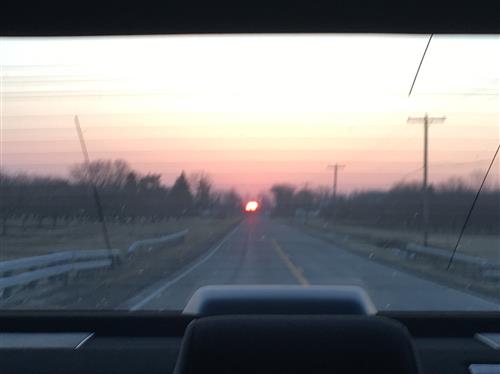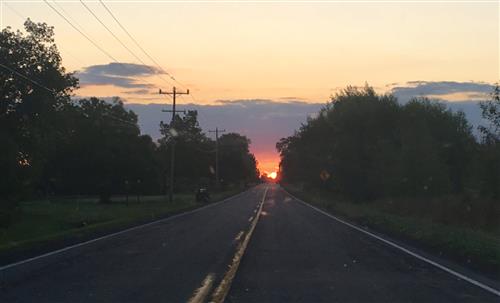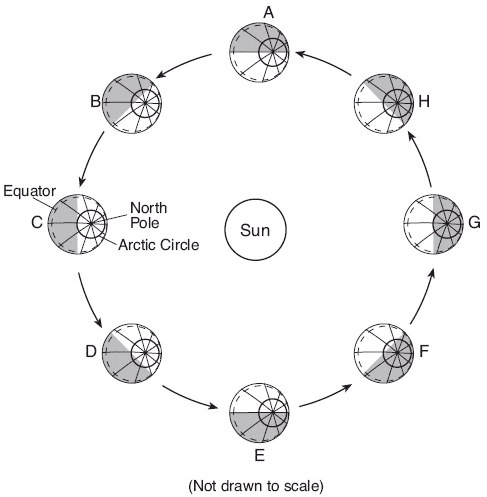-
Earth Science Journal
#4 Autumn Equinox
Answer in your journals using complete sentences.
Be sure to write so people can read and understand your answers.
Today is the last day of summer or the first day of fall!
1. In your own words, describe what you think happened to cause the Autumn (Fall) Equinox.
Draw pictures if you like.
Now use your review book to get the definition of "Equinox."
2. Equinox: Time at which the Sun is directly above the equator, and all places on the Earth have 12 hours of daylight and 12 hours of darkness. They mark the beginning of Spring and Fall.
3. Is it true that we get "about" 12 hours of daylight everywhere on Earth during the Equinox? No
I took this photo from last year's Equinox on my morning drive to Wilson.

4. What can you tell me about this road?
The road is aligned, running East-West.
We are looking due (directly) East!
Below is a photo of the same road that I took on the morning of 9/25/24.
 5. Do you notice anything different with the sunrise?The Sun is rising a little more to the right (south of due east).6. How many hours of sunlight are at the poles on the Equinox?
5. Do you notice anything different with the sunrise?The Sun is rising a little more to the right (south of due east).6. How many hours of sunlight are at the poles on the Equinox?At the North and South Poles during the Equinox, you would get 24 hours of sunlight!
The sun would circle you on the horizon because the Earth is spinning you under the sun!
The South Pole on the Equinox!
The Sun at the North Pole on Sept. 6
Notice that the Sun is just above the horizon because it is not quite the Equinox.Do you notice any difference in the direction in which the Sun appears to move?
At the North Pole, the Earth is spinning counterclockwise, which makes the Sun appear to move clockwise.
Imagine yourself in the middle of a clock. The Sun appears to move around you like the hour hand.
The Earth is spinning you to the left, making the Sun appear to move toward the right.
Please paste this image into your journal.
You will need to print it out.
Write these questions down and answer them in your journal.
7. Which position of the Earth do you think represents the Autumn (Fall) Equinox for us in Wilson?
Explain your reasoning.Hint: Position C is our first day of Summer (June 21).
8. Which position is our Vernal (Spring) Equinox? Explain.
9. Which position represents the Autumn (Fall) Equinox for people in the Southern Hemisphere?
Watch these videos to get a bigger perspective!
NOAA's new DSCOVR Satellite takes a new picture of the Earth every two hours, revealing how the planet would look to human eyes. The EPIC camera aboard the satellite captures the ever-changing motion of clouds and weather systems as they pass over the continents on our rotating, round Earth. The camera has now recorded a full year of life on Earth from its orbit, as seen above.
Why do we have seasons?
10. Explain in your own words why we see the equinoxes twice a year.
Reflection
Explain how the Earth's shape, rotation (spin), and revolution (orbit) make the equinoxes occur.
Bonus
Read this article below and describe in detail why there are not precisely equal times of day and night on the Equinox.
Please include drawings or images in your explanation.Equinox Myth Debunked
By Joe Rao, Space.com Skywatching ColumnistSick of long, hot summer days? Well, you're in luck. Astronomically speaking, autumn is about to begin in the north.
On Monday (Sept. 23), autumn begins astronomically in the Northern Hemisphere. This also marks the start of spring in the southern half of the globe.
This date is called an equinox, from the Latin for "equal night," alluding to the fact that day and night are then of equal length worldwide.But that is not necessarily correct.
Not so equal
Referring to the Equinox as being a time of equal day and night is a convenient oversimplification. For one thing, it treats night as simply the time the Sun is beneath the horizon and completely ignores twilight. If the Sun were nothing more than a point of light in the sky, and if the Earth lacked an atmosphere, then at the time of an equinox, the Sun would indeed spend one-half of its path above the horizon and one-half below.
But in reality, atmospheric refraction raises the Sun's disc by more than its own apparent diameter while it is rising or setting. Thus, when the Sun looks like a reddish-orange ball just sitting on the horizon, it's really an optical illusion. It is actually completely below the horizon.
In addition to refraction hastening sunrise and delaying sunset, there is another factor that makes daylight longer than night at an equinox: Sunrise and sunset are defined as the times when the first or last speck of the Sun's upper or lower limbs — not the center of the disc — are visible above the horizon.
And this is why if you check your newspaper's almanac or weather page on Monday and look up the times of local sunrise and sunset, you'll notice that the duration of daylight, or the amount of time from sunrise to sunset, still lasts a bit more than 12 hours.
In New York City, for instance, sunrise is at 6:43 a.m., and sunset comes at 6:54 p.m. So the amount of daylight is not 12 hours, but rather 12 hours and 11 minutes. Not until Sept. 26 are the days and nights truly equal. (On Sept. 26, sunrise is at 6:47 a.m., and sunset is 12 hours later).
At the North Pole, the Sun currently is tracing out a 360-degree circle around the entire sky, appearing to skim just above the edge of the horizon. At the moment of this year's autumnal Equinox, it should theoretically disappear completely from view, and yet its disc will still be hovering just above the horizon. Not until 52 hours and 10 minutes later will the last speck of the Sun's upper limb finally drop completely out of sight.
This strong refraction effect also causes the Sun's disc to appear oval when it is near the horizon. The amount of refraction increases so rapidly as the Sun approaches the horizon that its lower limb is lifted more than the upper one, distorting the Sun's disc noticeably.
Not as dark as it seems
Certain astronomical myths die hard. One of these is that the entire Arctic region experiences six months of daylight and six months of darkness. Often, "night" is simply defined by the moment when the Sun is beneath the horizon as if twilight didn't exist. This fallacy is repeated in innumerable geography textbooks, as well as travel articles and guides.
But twilight illuminates the sky to some extent whenever the Sun's upper rim is less than 18 degrees below the horizon. This marks the limit of astronomical twilight when the sky is indeed totally dark from horizon to horizon.
There are two other types of twilight. Civil (bright) twilight exists when the Sun is less than 6 degrees beneath the horizon. It is loosely defined as when most outdoor daytime activities can be continued. Some daily newspapers provide a time when you should turn on your car's headlights. That time usually corresponds to the end of civil twilight.
So, even at the North Pole, while the Sun disappears from view for six months beginning Sept. 25, to state that "total darkness" immediately sets in is hardly the case. In fact, civil twilight does not end there until Oct. 8.
When the Sun drops down to 12 degrees below the horizon, it marks the end of nautical twilight, when a sea horizon becomes difficult to discern. In fact, at the end of nautical twilight, most people will regard night as having begun. At the North Pole, nautical twilight does not end until Oct. 25. Finally, astronomical twilight — when the sky indeed becomes completely dark — ends Nov. 13. It then remains perpetually dark until Jan. 29, when the twilight cycles begin anew. So, at the North Pole, the duration of 24-hour darkness lasts almost 11 weeks, not six months.
More here: http://stevekluge.com/astronomy/sunrise.html

